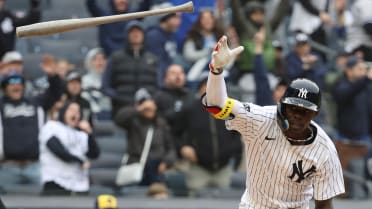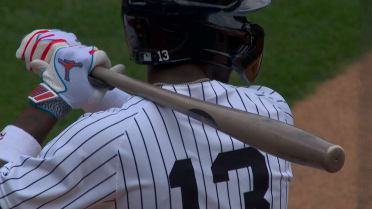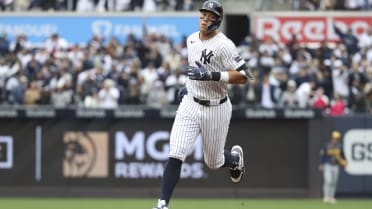The winds blew strong through Cooperstown, N.Y., on Sunday, with the threat of a thunderstorm looming. And so the ceremony on the grounds of the Clark Sports Center celebrating the National Baseball Hall of Fame’s Class of 2022 was slightly truncated, with the typical video tributes cut so that the speeches could be completed without being interrupted by rain.
But for a class that is evidence of the winds of change that have blown through baseball over the decades, the conditions were appropriate. That the class was headlined by David Ortiz, a native of the Dominican Republic who developed into one of the most feared sluggers in history, spoke to the sport’s reach and representation. It’s a story that weaves its way through the Class of ’22, tracing back through the generations to include Golden Days and Early Baseball Era committee inductees Tony Oliva and Jim Kaat, and the late Bud Fowler, Gil Hodges, Minnie Miñoso and Buck O’Neil.
Ortiz -- the 58th first-ballot Hall of Famer and the 14th since 2014 -- attracted a considerable crowd, with Red Sox paraphernalia and Dominican Republic flags aplenty. There was some irony in Ortiz receiving his plaque bearing a Red Sox logo on what was also a big day for the Twins, who famously released him just before his big breakout in Boston. Kaat and Oliva are depicted on their plaques wearing Minnesota’s mark.
Here's a look at how the seven new inductees reached the Hall and what was said.
Jim Kaat
This was a long-awaited honor for the 83-year-old Kaat. But then again, the concept of length suits a reliable left-hander who pitched in 25 seasons over four decades from 1959-83. Though Kaat was a member of the 1982 World Series champion Cardinals, his best years came with the Senators/Twins, for whom he debuted and toed the rubber for 15 seasons. His 625 career games started rank 17th all time, and his 4,530 1/3 innings rank 25th.
A longtime broadcaster, currently for MLB Network, Kaat is no stranger to public speaking. And so unsurprisingly, he was adept at telling the story of his baseball life, from attending his first Major League game (a Red Sox-Tigers doubleheader at Briggs Stadium in 1946) to winning it all, along with a healthy amount of perspective.
“We have a world with millions of people who are disadvantaged, oppressed, wake up daily to pain and suffering,” he said. “I was able to live -- and still am -- a comfortable life for over 83 years. I had great parents. I grew up in a great community, Zeeland, Mich. And I was gifted with the ability to play baseball. And I’m grateful for that.”
Kaat specifically cited his experience in the Class C league in Missoula, Mont. -- under player/manager Jack McKeon, who was in attendance on Sunday -- as instrumental in his career. He said McKeon gave him the leeway to compile innings, pitch through difficulty and “figure out a way to get out” of jams.
“Sometimes I did, sometimes I didn’t,” Kaat said. ‘But I thank him for letting me take ownership of the situation and the game and my position.”
Bud Fowler
Cooperstown is known -- incorrectly but enduringly -- as the “birthplace of baseball.” And yet Fowler, who was born John W. Jackson, is actually the first Hall of Fame inductee who hails from Cooperstown.
Fowler’s induction partners, appropriately, with the Hall of Fame’s recent undertaking of a two-year project to create a permanent exhibit on Black baseball. Fowler is believed to have been the first Black player to integrate white professional leagues, debuting in the International Association in 1878. Rampant racism forced him to bounce from team to team until the color barrier became more explicit and relegated him to all-Black teams, but he was a visionary who imagined the idea of the Negro Leagues decades before they were actually formed.
Hall of Famer Dave Winfield, one of a handful of former players on the advisory board for the new exhibit, spoke on behalf of the late Fowler, who passed away in 1913, on induction day. Winfield visited Fowler’s gravesite on his way into Cooperstown to pay homage and, with his booming voice, gave the crowd a worthwhile lesson about Fowler’s place in American history.
“There’s an unmistakable line you can follow from Bud Fowler to Andrew Rube Foster, who created the Negro Leagues in 1920, to Jackie Robinson in 1947 and through the other inductees we celebrate here today,” Winfield said. “So I ask -- or I suggest -- that you remember Bud Fowler in a broad context, not just as a pioneering African-American professional baseball player. Remember him as a skilled athlete who endured obstacles that are hard to imagine today, as an early force in integrating the game and as a visionary who attempted to create a league of their own when the roadblocks of his time were present.”
Minnie Miñoso
A 13-time All-Star and member of the “Go-Go” White Sox of the 1950s and ‘60s, Miñoso had a career that touched five decades, from his 1947 debut in the Negro Leagues to his 1949 debut in the American League to his 1980 activation, at age 54, as a pinch-hitter for two games. Most important, he is remembered as the Latino answer to Jackie Robinson, a player whose performance helped blaze a trail for the many dark-skinned Latin players who now make up such an important percentage of the big league populace.
Alas, with his passing in 2015, he did not get to see that long, productive and historically meaningful career fully recognized by the Hall of Fame voting process. His widow, Sharon Rice-Miñoso, gave the speech on his behalf.
“While Minnie’s been inducted to other esteemed Halls of Fame, including Cuba and the Dominican Republic, it would have meant the world to Minnie to see this day and be here himself,” Rice-Miñoso said. “As a dark-skinned Afro-Latino in the height of segregation, he knew of the racial and cultural challenges that he would endure coming to the United States. He tolerated them so he could play professional baseball and fulfill his own American dream. Little did he know as a pioneer that he was opening doors for countless others behind him, some of whom sit proudly on this stage.”
Rice-Miñoso highlighted her late husband’s ability to smile through hardships and injustices.
“Today’s honor bestowed upon Minnie is most appropriate not only as a Hall of Fame player,” she said, “but Minnie was always a gentleman and Hall of Fame person off the field and in the community.”
Tony Oliva
It was fitting that Oliva, who idolized Miñoso and followed in his footsteps, was formally inducted immediately after his Cuban countryman.
Before Oliva even took the stage, his induction had a heartwarming reunion attached to it. The Twins and Sen. Amy Klobuchar had arranged for Oliva’s younger brother, Juan Carlos Oliva, who resides in Cuba, to obtain a visa so he could travel to Cooperstown to be there on induction day. The two had not seen each other in the U.S. since 2009.
“I have a lot of family here today who came out from a long, long way,” Oliva said. “Friends who came a long, long way. I appreciate it very much. Especially those people in Minnesota. I’ve lived in Minnesota for 60 years, and Minnesota is my home.”
After immigrating from Cuba -- with the help of another younger brother’s birth certificate, which he used to obtain a passport -- and signing with the Twins in 1961, Tony Oliva became the first native of the island to win Rookie of the Year honors, in 1964. He went on to win three batting titles and lead the AL in hits five times, and he was an eight-time All-Star.
Like his former Twins teammate Kaat, Oliva had to patiently await his Hall call after falling short on 15 tries on the BBWAA ballot from 1982-96. But mere days after turning 84, he finally got his moment, and he remarked how happy he was to have finally gotten the call.
“I was thinking that was my last bus,” he said. “If I don’t go into the Hall of Fame that time, it’s all over for Tony.”
Gil Hodges
The best word to describe Hodges, in terms of his baseball life, is winner. He won as a player, he won as a manager. He was an eight-time All-Star in an 18-year playing career as a first baseman for the Dodgers and Mets, winning three Gold Gloves and leading the Dodgers to seven NL pennants and two World Series titles. At the time of his retirement in 1963, his 370 career homers were third-most for a right-handed hitter.
Then Hodges turned his sights to managing. After five years with the Senators, he took over a Mets team that had never won more than 66 games and turned it into a World Series champion during the “Miracle Mets” season of 1969.
A sudden heart attack in 1972 took Hodges’ life at the too-young age of 47. His highest BBWAA voting percentage was 63.4 in his final year of eligibility in 1983, but the Golden Days Era Committee got him in this year. His daughter, Irene Hodges, handled his induction speech.
“Fifty years ago not only did the Mets and Dodgers lose one of their heroes, we lost a husband and a father,” she said. “Our greatest gift, although my father’s life was cut so short, was his influence on those around him.”
Through her speech, Irene Hodges made sure the crowd got to know her father not just as a winning player and manager but as a man of integrity, a man who served in the Marine Corps at the Battle of Okinawa and who imparted important lessons on his children and his players. More important, she cited his welcoming relationship with Jackie Robinson at a time when few white players were willing to treat Robinson with the dignity he deserved.
“Nothing was more important to my dad than giving Jackie all of his support,” she said. “We were like family with the Robinsons. Jackie’s kids played in our house, we played in theirs. … My dad had an open heart for Jackie. They were close until the day my dad passed. On the day of my father’s funeral, Jackie cried uncontrollably, saying, ‘Next to my son’s death, this is the worst day of my life.’”
Buck O’Neil
One of the great speeches in induction day history was O’Neil’s honoring of the Negro League greats elected into the Class of 2006. That O’Neil -- who had an outsize role as a Negro Leagues ambassador in addition to his influential career as a player, manager, scout and the first Black AL/NL coach -- was not selected as part of that class was a source of great contention and consternation. But “Buck,” as he is lovingly known, had not only the grace to shake off the snub but the personality to master the moment. The 92-year-old had every person in the crowd -- even the Hall of Famers on the dais -- hold hands with the person next to them and then sang, “The greatest thing in all my life is loving you …”
Sadly, O’Neil passed away just a few months later, and he did not get to live to see his rightful induction into the Hall. But he left behind no shortage of people who loved him, including his niece, Dr. Angela Terry, who spoke on his behalf.
“We applaud the committee for not subjectively limiting their interpretation of an exceptional career in baseball to a singular focus on statistics,” Terry said. “In other words, expanding their view to include the totality of one’s work in baseball.”
The Hall of Fame’s Buck O’Neil Lifetime Achievement Award, established in 2008, spoke to his importance to the sport. And on the day he finally got his own Hall plaque, Terry celebrated his spirit.
“For those of us who knew Uncle John, can’t you hear him excitedly voicing one of his favorite phrases, ‘Man oh man, nothing could be better!’” Terry said. “Our Uncle John was a man for all seasons, whose core was brotherly love.”
David Ortiz
A 10-time All-Star who owned October, Ortiz always had a flair for the dramatic in the big moments. This induction ceremony -- which began with a performance of "The Star-Spangled Banner” by Ortiz’s daughter Alex -- certainly qualified as a big moment in the 46-year-old’s life, and he had admitted to a rare bout with nervousness before delivering his speech.
But as usual, he crushed it, with a speech in both English and Spanish that drew big cheers from the crowd, which included no shortage of people from his native Dominican Republic.
“This game is so important here in America and around the world,” he said in thanking Major League Baseball as an institution. “Thank you for all the support you have given baseball as a sport, so that it continues to be part of our culture and part of the heart of all the fans worldwide.”
Ortiz finished his electric career with a .286/.380/.552 slash, 541 home runs (17th all time), 632 doubles (12th all time), 1,768 RBIs (23rd all time), 2,472 hits and 1,319 walks (T-41st all time). He had 10 seasons of at least 100 RBIs, finished in the top five of the AL MVP voting in five straight seasons from 2003-07 and led the Majors in OPS (1.021) in his final season at age 40 in 2016.
But Ortiz will be remembered most for his performance in the postseason. He helped Boston break the so-called “Curse of the Bambino” in 2004 by going 12-for-31 with three homers, 11 RBIs and the walk-off RBIs in two games in the epic seven-game ALCS against the Yankees. He was also a key figure in title runs in 2007 and in 2013, helping to heal Boston’s broken heart after the Marathon bombings. Few players in baseball history meant more to an organization and a city than Ortiz did in his 14 seasons with the Red Sox.
Anthony Castrovince has been a reporter for MLB.com since 2004.




